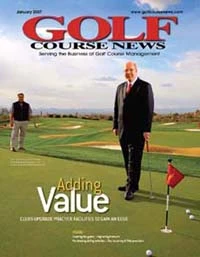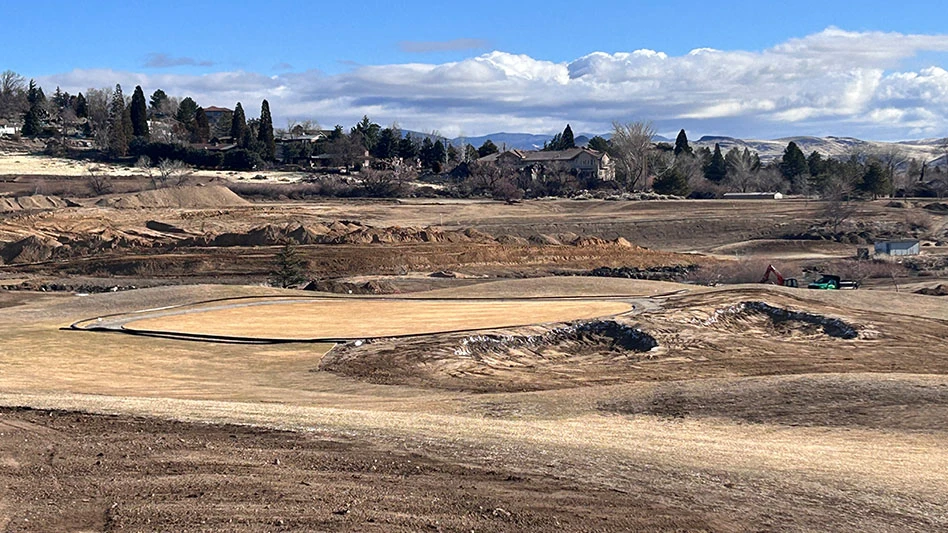Globetrotting consulting agronomist Terry Buchen visits many golf courses annually with his digital camera in-hand. He will share helpful ideas relating to maintenance equipment from the golf course superintendents he visits – as well as a few ideas of his own – with timely photos and captions that explore the changing world of golf course management.
Easy come, E-Z-GO
In the midst of replacing the golf cart fleet at Congress Lake Club in Hartville, Ohio, Scott Frase, CGCS, and Mike Florea, equipment manager, kept one – a 1989 gasoline-model E-Z-GO with a 2-cycle, oil-injection 1-cylinder engine – and turned it into a functional mechanic’s cart.
Florea made no modifications to the cart’s engine, but he removed the bag rack and built a 1/4-inch-thick angle iron frame to support the aluminum diamond-plate bed he built using a local fabrication shop. Two aluminum tool boxes were placed on either side of the bed. A hinged aluminum tailgate is held in place on the top end with a flat piece of aluminum and removable lynch pins.
At the bottom of the cart, where the bag rack used to be, Florea installed a 5-gallon air tank for use on the course. The tank is protected with an aluminum cover, which is bolted to the back panel. The back panel houses a pressure gauge and male and female air-hose quick connects.
A 2-inch receiver hitch was welded in place to pull utility trailers, which have turf tires. The windshield that came with the golf cart was reduced to 6-inches high to act as a wind deflector. The vinyl seats were painted with a charcoal-gray, automotive metallic enamel paint. The oversize wheels and tires were acquired from Cart Parts (www.cartparts.com), and a lift kit was made in-house and installed to raise the cart’s height by 3 inches so the cart wouldn’t be centered too high.
Florea even took a piece of aluminum, put his first name on it and put it next to the ignition switch.
A heavy-duty hauler
A trailer transports sod pallets throughout the course at The Old Collier Golf Club in Naples, Fla. It was conceived and designed by Todd Draffen, golf course superintendent; Mike Koopman, equipment manager; and J.W. Stidham, assistant equipment manager, under the auspices of Tim Hiers, CGCS, director of golf course operations.
Koopman ordered a 4,000-pound-capacity utility wagon that had a solid axle, no suspension, wheels with no brakes and 35-psi tires from Northern Tool & Equipment Co. (www.northerntool.com) for about $500.
Four 8-feet-long pieces of 2-inch-square tubing 1/4-inch thick ($110) was welded and bolted in place and spaced equally on top of the running gear, which has a telescoping rod connecting the front and rear axles set on the shortest setting. The tie rods were beefed up to handle the weight of the steel plate and about 2,000 pounds of sod. A 4-feet-by-8-feet steel plate ($200) 1/4-inch thick was purchased locally and cut to fit where the front wheels articulate back and forth by the tongue. The steel plate was painted with a rust protector ($20).
The trailer is pulled by a Toro Workman utility vehicle to prevent cracking or damaging the cart paths.
Instead of placing a pallet on the ground in one location, the trailer can be moved anywhere the sod is being laid. The trailer also can be retrofitted with 5-feet-high wooden side boards to haul bales of pine straw or other supplies. GCN

Explore the January 2007 Issue
Check out more from this issue and find your next story to read.
Latest from Golf Course Industry
- The Cabot Collection announces move into course management
- Carolinas GCSA raises nearly $300,000 for research
- Advanced Turf Solutions’ Scott Lund expands role
- South Carolina’s Tidewater Golf Club completes renovation project
- SePRO to host webinar on plant growth regulators
- Turfco introduces riding applicator
- From the publisher’s pen: The golf guilt trip
- Bob Farren lands Carolinas GCSA highest honor







